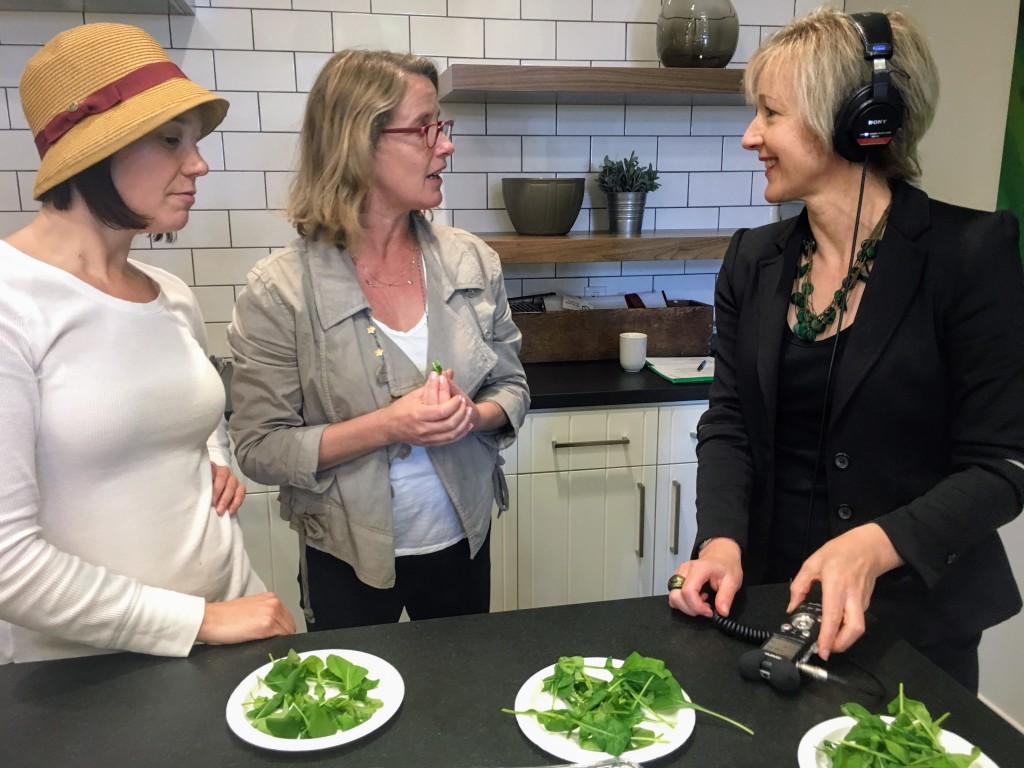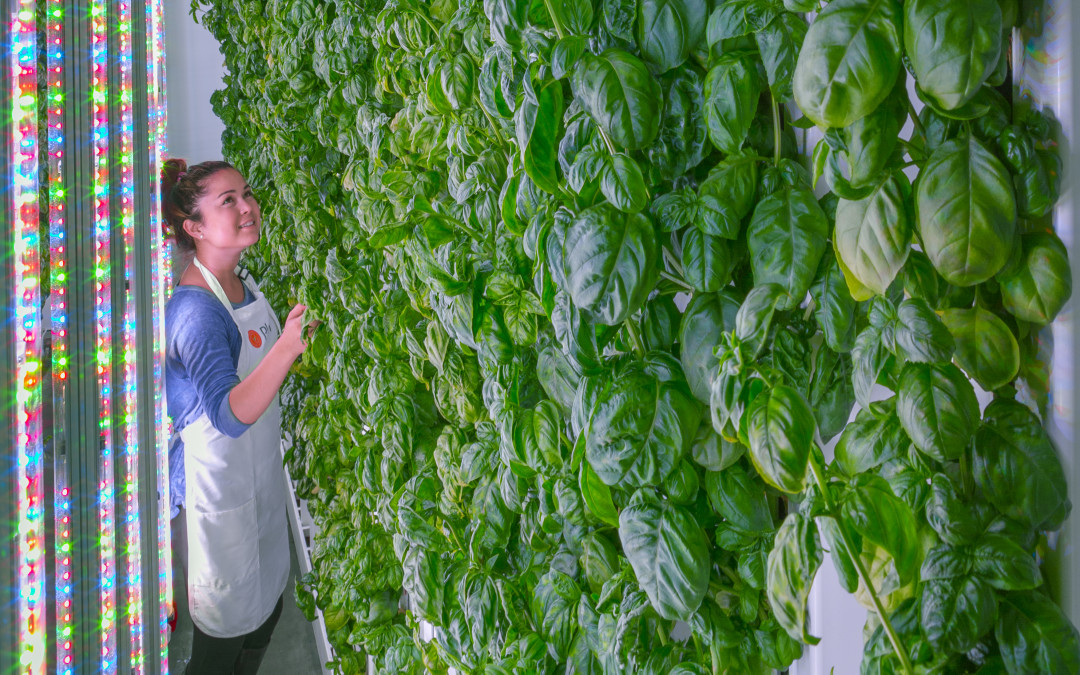Plenty, a Silicon Valley company, plans to revolutionize farming by bringing it indoors and dramatically reducing water use. It has ambitious plans to replicate its warehouse farms in Japan, China and across Europe. BBC Click’s Alison van Diggelen explores: the veracity of its technology; its environmental claims; its use of AI and automation; and how it plans to disrupt the agricultural industry.
Listen to the BBC Click report and discussion with Gareth Mitchell and Bill Thompson at the BBC World Service (@9:35 in the podcast)
Highlights coming soon at Fresh Dialogues on iTunes
Here’s a transcript of the original (lengthier) report:
Plenty’s Patrick Mahoney (inside warehouse, sounds of farm fans, air-conditioning, beeps) : What you see is a cathedral like room – in which there are rows of towers on which our plants grow. This lush abundant overload of beautiful greens that we’re growing indoors here.
van Diggelen: Climate change is exacerbating food shortages by delivering more extreme temperatures, storms and severe droughts. Can technology help grow food more efficiently, using a fraction of the land and water of traditional agriculture? Matt Bernard, the CEO of Plenty, an indoor farming company in Silicon Valley believes it can. He grew up on a cherry farm in Wisconsin and says that fixing the water industry has been a driving force for him ever since. Barnard says that today’s agriculture industry uses about 80% of global water consumption and could use a “heck of a lot less.” His solution is “vertical farming” – massive indoor warehouses with powerful LEDs, and a super-efficient watering system. It uses just 1% of the water needed for a traditional field, he says.
Barnard: In the size of a couple of football fields we can grow 200 to 1000 acres. If you look at a football pitch – say FC Barcelona – we can grow what would grow on that field in the space of one net. That’s how land efficient it is. We get to grow all year long, without seasonality. [because we give the plants the perfect environment, they’re growing much faster than they do out in the field.
van Diggelen: Unlike rivals like, that grow produce on massive trays, Plenty’s plants grow out of 20-feet long poles and are fed with nutrient-rich water. Such soil-free systems, called hydroponics, have been around for decades, but recent tech advances have enabled a brave new world of indoor farming, on a scale that’s unprecedented. The temperature, humidity, and light is controlled by sensors and electronics, a system known as the Internet of Things or “IoT.” Here’s Bernard:
Bernard: We wouldn’t exist if it wouldn’t be for things like LED lights, if they hadn’t come down in cost by 98% over the last 7-8 yrs and the efficiency hadn’t improved.
van Diggelen: What other tech breakthroughs and cost curve reductions have been key?
Bernard: IoT sensors were too expensive 5 years ago, and weren’t practical enough – they were relatively dumb. Today the story is very different, camera tech and software technology make cameras as effective as possible. That tech and its cost effectiveness are critical to computer vision – a technology we need to run an effective farm.
van Diggelen: Can you break that down? What’s computer vision?
Bernard: The pairing of camera and vision tech with machine learning. Developing algorithms to allow machines to learn from the information they gather over time from what’s happening on the farm. Machine Learning was a couple of orders of magnitude more expensive only five years ago and also not effective enough to make use of in a farm.
van Diggelen: How does that make you better farmers?
Bernard: In the field, even in greenhouse, you don’t control all the inputs.
We end up with a giant optimization problem and we need to ask the machines to help if we want to learn and move as fast as possible.
van Diggelen: The sensors and software can spot plant problems before they’re obvious to a human he says. So, instead of using pesticides, this monitoring means ladybugs are its only pest control.
Many companies are vying for a slice of this fresh produce pie. And several have withered on the vine as they strive for economic viability. But with over 200 million dollars, Plenty is the best funded enterprise in the field. With funding and scaling expertise from Softbank’s Vision Fund, Amazon’s Jeff Bezos and former Google Chairman, Eric Schmidt, Plenty has an aggressive plan to build its intensive farms close to major world cities. Providing local produce is key to its business model.
Barnard points out that the average lettuce travels about 2000 miles from field to grocery store in the U.S. The company aims to increase food nutrition and prolong shelf-life by what he describes as “collapsing the time from farms to tables, from weeks to minutes.”
In SF, the company’s focus is R&D, but it’ll start delivering produce this year from its first warehouse farm in Seattle. This 100,000 sf facility will powered entirely by renewable energy. But, like many tech dreams, marinated in Silicon Valley’s Kool Aid, is this all more hype than substance?
Jon Foley is the Executive Director of the California Academy of Sciences. I caught up with him on the phone….
Foley: They use an enormous amount of resources to build the infrastructure to make these indoor farms. They use an enormous amount of energy to power them…to replace the sun and use indoor LED lighting. But we didn’t run out of sun!
The only benefits is maybe for water but food miles and food transportation isn’t really a huge problem for the environment. The biggest emissions of GHG from agriculture are not due to food miles, it’s things like deforestation, and too many cattle burping methane.
van Diggelen: Foley points out that many crops like wheat and corn just won’t grow indoors. They need heat and wind to develop stalks.
Foley: You see lots of vegetable greens: lettuce, arugula…you’re basically growing garnish.
van Diggelen: Foley also questions scalability…
Foley: Are we going to truly make a dent in global land-use that cost vastly more than farmland in Kansas? They’re not a silver bullet. They’re not really addressing the biggest problems we face feeding the world sustainably, it’ll be expensive and I doubt it’ll be reaching the world’s poorest billion.
van Diggelen: Another existential challenge is a pests outbreak. Due to the intensive nature of the farm, just one infestation could be catastrophic. Right now, the Plenty team is paranoid about pests. Workers and visitors must wear overalls and rubber boots disinfected in special shoe baths. A powerful ceiling fan is set up to remove any unwanted pests like Spider Mites.
Although the company plans to focus first on the U.S. market, another agriculture expert, Professor Heiman Lieth of UC Davis suggests the biggest opportunity might be in China where there’s a shortage of safe fresh produce, and government incentives for “green jobs” and subsidized renewable energy sources. The United Arab Emirates also offers a fertile venue with cheap power and affluent consumer demand.
But will consumers love the product enough to pay a premium?

Atmos: lettuce breaking sniffing…
(Lettuce container opening)
Keller: This was harvested ten minutes ago….We measure the size (tape measure unrolling). It’s ~9 cm – within accepted range. It meets the arugula profile…We’re on track…
van Diggelen: At this futuristic farm, even the taste testing is tech centered. The distinct taste, smell, even the size of each sample crop is tested twice a day and inputed to a computer program that features colorful pie-charts. Human and machine analysis creates a quick reaction-loop inside the warehouse to ensure a consistent taste and quality.
My mouth was watering by the time I met the taste experts, in Plenty’s white-tiled kitchen. Chief taste testers, Christine Keller and Leta Soza offered me what looked like baby spinach, but was in fact the sweetest, spiciest arugula I’ve ever tasted.
Keller (sniffing): We break it…We put our faces in the product and we take little sniffs so you detect every smell in there: Fresh cut grass, a very spicy wasabi…When we’re done, we roll it up into a little ball (Crunching, chewing…)
Keller: Our data teams and our plant science teams continue to improve the product because we know all the environmental controls going in and the sensory things coming out. It’s remarkable. It’s not been done.
Keller: We’re each filling out 3-digit codes for where the product came from, which room, (what farm, if you will) so we can track it back to all of the computer science that’s telling us the exact recipe that went in there.
Soza: (Typing and form filling): that’s slightly more than a four on the sweet actually – wasabi’s beautiful and so is bitter. Let’s send that off so farm ops can have the data and press on. (Laughter)
van Diggelen: It’s certainly a brave new vision for farming. But Plenty needs to scale up and surmount the cost challenges it faces, and keep growing tastier products than conventional farms, with a fraction of the water. It also needs to find markets where the demand and the price is “just right.” Only then will they flourish as well as their leafy green produce. Right now, it looks like a very tall order.
Listen to the BBC podcast or to the player above to hear a lively discussion of this report and some insights from Click’s Bill Thompson.




